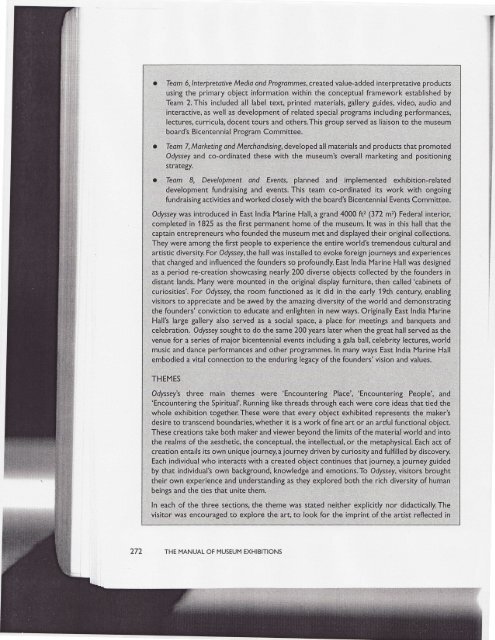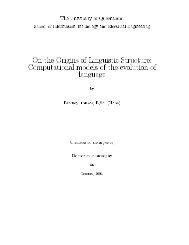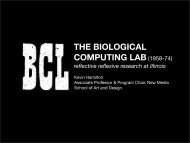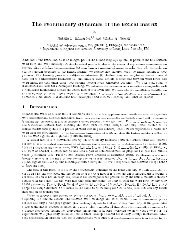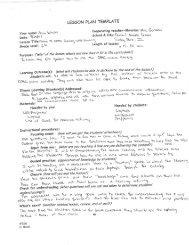Planning and Managing an Exhibition Programme
Planning and Managing an Exhibition Programme
Planning and Managing an Exhibition Programme
Create successful ePaper yourself
Turn your PDF publications into a flip-book with our unique Google optimized e-Paper software.
o<br />
Teom 6,lnterpretotive Medio ond Progrommes, created value-added interpretative products<br />
using the primary obiect information within the conceptual framework established by<br />
Team 2.This included all label texg printed materials, gallery guides, video, audio <strong><strong>an</strong>d</strong><br />
interactive, as well as development of related special programs including perform<strong>an</strong>ces,<br />
lectures, curricula, docent tours <strong><strong>an</strong>d</strong> others.This group served as liaison to the museum<br />
board's Bicentennial Program Committee.<br />
fs<br />
E<br />
i<br />
tr<br />
. Team T,Morketing <strong><strong>an</strong>d</strong> Merchondisng, developed all materials <strong><strong>an</strong>d</strong> products that promoted<br />
Odyssey <strong><strong>an</strong>d</strong> co-ordinated these with the museum's overall marketing <strong><strong>an</strong>d</strong> positioning<br />
straEegy.<br />
. Teom 8, Development ond Events, pl<strong>an</strong>ned <strong><strong>an</strong>d</strong> implemented exhibition-related<br />
development fundraising <strong><strong>an</strong>d</strong> events. This team co-ordinated its work with ongoing<br />
fundraising activities <strong><strong>an</strong>d</strong> worked closely with the board's Bicentennial Events Committee.<br />
Odysseywas introduced in East India Marine Hall, a gr<strong><strong>an</strong>d</strong> 4OO0 fii (372 m') Federal interior,<br />
completed in 1825 as the first perm<strong>an</strong>ent home of the museum. lt was in this hall that the<br />
captain entrepreneurs who founded the museum met <strong><strong>an</strong>d</strong> displayed their original collections.<br />
They were among the first people to experience the entire world's tremendous cultural <strong><strong>an</strong>d</strong><br />
artistic'diversity. For Odyssey,the hall was installed to evoke foreign iourneys <strong><strong>an</strong>d</strong> experiences<br />
that ch<strong>an</strong>ged <strong><strong>an</strong>d</strong> influenced the founders so profoundly. East India Marine Hall was designed<br />
as a period re-creation showcasing nearly 200 diverse objects collected by the founders in<br />
dist<strong>an</strong>t l<strong><strong>an</strong>d</strong>s. M<strong>an</strong>y were mounted in the original display furniture, then called 'cabinets of<br />
curiosities'. For Odyssey, the room functioned as it did in the early 19th century enabling<br />
visitors to appreciate <strong><strong>an</strong>d</strong> be awed by the amazing diversity of the world <strong><strong>an</strong>d</strong> demonstrating<br />
the founders' conviction to educate <strong><strong>an</strong>d</strong> enlighten in new ways. Originally East India Marine<br />
Hall's large gallery also served as a social space, a place for meetings <strong><strong>an</strong>d</strong> b<strong>an</strong>guets <strong><strong>an</strong>d</strong><br />
celebration. Odyssey sought to do the same 200 years later when the great hall served as the<br />
venue for a series of major bicentennial events including a gala ball, celebrity lectures, world<br />
music <strong><strong>an</strong>d</strong> d<strong>an</strong>ce perform<strong>an</strong>ces <strong><strong>an</strong>d</strong> other programmes. In m<strong>an</strong>y ways East India Marine Hall<br />
embodied a vital connection to the enduring legacy of the founders' vision <strong><strong>an</strong>d</strong> values.<br />
THEMES<br />
Odyssey's three main themes were 'Encountering Place', 'Encountering People', <strong><strong>an</strong>d</strong><br />
'Encountering<br />
the Spiritual'. Running like threads through each were core ideas that tied the<br />
whole exhibition together.These were t}at every object exhibited represents the maker's<br />
desire to tr<strong>an</strong>scend boundaries, whether it is a work of fine art or <strong>an</strong> artful functional object.<br />
These creations take both maker <strong><strong>an</strong>d</strong> viewer beyond the limits of the material world <strong><strong>an</strong>d</strong> into<br />
the realms of the aesthetic, the conceptual, the intellectual, or the metaphysical. Each act of<br />
creation entails its own unique journey,a journey driven by curiosity <strong><strong>an</strong>d</strong> fulfilled by discovery.<br />
Each individual who interacts with a created object continues that journey, a journey guided<br />
by that individual's own background, knowledge <strong><strong>an</strong>d</strong> emotions.To Odyssey, visitors brought<br />
their own experience <strong><strong>an</strong>d</strong> underst<strong><strong>an</strong>d</strong>ing as they explored both the rich diversity of hum<strong>an</strong><br />
beings <strong><strong>an</strong>d</strong> the ties that unite them.<br />
In each of the three sections, the theme was stated neither explicitly nor didactically.The<br />
visitor was encouraged to explore the art, to look for the imprint of the artist reflected in<br />
THE MANUAL OF MUSEUM EXHIBITIONS


